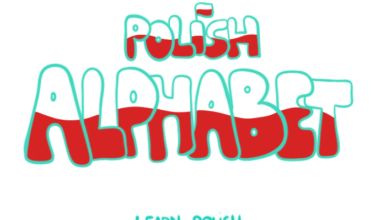Colors in polish Name and Pronounce – Colour, Pronunciation
April 16, 2023 2023-11-19 12:40Colors in polish Name and Pronounce – Colour, Pronunciation
What are the basic colors in Polish language?
The basic colors in Polish are:
- Czerwony (Red)
- Niebieski (Blue)
- Zielony (Green)
- Żółty (Yellow)
- Pomarańczowy (Orange)
- Różowy (Pink)
- Brązowy (Brown)
- Szary (Gray)
- Biały (White)
- Czarny (Black)

Word for blue in Polish is “niebieski,” while green is “zielony” and yellow is “żółty.” Red translates to “czerwony,” orange is “pomarańczowy,” and purple is “fioletowy.” White is “biały,” black is “czarny,” and gray is “szary.” However, there are a few additional color words in Polish that may not be familiar to speakers of other languages. For example, “granatowy” is a deep navy blue color, “magenta” is “magenta,” and “błękitny” is a light blue color similar to sky blue. Additionally, there are a few color words in Polish that have more specific meanings than their English counterparts. For example, the word “brązowy” refers specifically to the color brown, while in English, “brown” can refer to a range of shades from light tan to dark chocolate. Similarly, the word “różowy” refers specifically to a bright pink color, while in English, “pink” can refer to a range of shades from pale blush to hot pink. It’s important to note that the way that color words are used in Polish can be different from in other languages. For example, Polish uses numerals to indicate shades of colors, rather than adding adjectives as in English. So, to indicate a darker shade of blue in Polish, one might say “niebieski dwa” (blue two) rather than “darker blue.” Additionally, there are a few traditional Polish color associations that may not be common in other cultures. For example, red and white are the national colors of Poland and are often used in patriotic contexts. Similarly, green is often associated with nature and freshness, while blue is associated with trust and reliability. In general, the basic colors in Polish are quite similar to those in other languages, with a few exceptions and specific cultural associations. Whether you’re learning Polish for the first time or already speak the language fluently, it’s important to take these nuances into account when using color words in different contexts. By understanding the basic building blocks of Polish vocabulary, including color words, you’ll be better equipped to communicate effectively in everyday contexts and make connections with Polish speakers around the world.
More Colors Vocabulary in Polish
The polish language is abundant with various vocabulary, including words that describe different colors. Knowing these words can help improve communication, especially when one is trying to describe a particular object or subject. English speakers may have to learn the polish color vocabulary to better understand the language. For example, the color blue in Polish is called “niebieski.” The term “czarny” refers to black, while “biały” means white. Other colors in the polish vocabulary include “zielony” for green, “czerwony” for red, “pomarańczowy” for orange, “żółty” for yellow, “fioletowy” for purple, and “różowy” for pink. Additionally, the polish language has specific words for different shades and hues of colors, making it possible to describe colors accurately. Familiarizing oneself with these color terms is crucial in everyday communication, whether for personal or business purposes.
The Colors In Polish
Polish is a language known for its vibrant and distinctive use of color. One of the most commonly used colors in Polish is blue, which is known as “niebieski.” However, there are many other colors in Polish that are equally interesting and compelling. For anyone looking to learn a new language, the colors in Polish can be a great place to start. By learning the words for different colors, learners can practice their pronunciation and build their vocabulary in a fun and engaging way. One reason why the colors in Polish are so interesting is their use in everyday language. For example, in Polish, the color “light blue” is referred to as “jasnoniebieski” which can be translated to “bright blue.” This word isn’t just used to describe colors, either; it’s also used to describe moods, feelings, and experiences. Another interesting example is the word “różowy,” which means “pink.” This color is often associated with femininity and is often used to describe things like clothing, flowers, and makeup. If you’re interested in learning about the colors in Polish, there are many resources available to help you. You could try learning through online language courses or by using flashcards and other study aids. You could also try practicing your listening skills by watching Polish shows or movies with subtitles. No matter how you choose to learn, one thing is for sure: the colors in Polish are a fun and fascinating way to explore this unique language. So why not give it a try and see what new horizons this language can open for you?
Pronounce colors in polish
Polish is an intriguing language, and pronouncing colors in Polish can be quite tricky. Colors in Polish are considered as adjectives and are declined based on the gender, number, and case of the noun they are describing. This means that the pronunciation of colors in Polish can differ depending on the context of the sentence. Firstly, let’s have a basic look at how to pronounce some basic colors in Polish. Red in Polish is czerwony pronounced as ‘CHEH-rrvo-ny’. Blue is niebieski pronounced as ‘nyeh–BYEH-skee’, green is zielony pronounced as ‘zheh–LOH-ny’, yellow is żółty pronounced as ‘ZHOH-oo-tai’, pink is różowy pronounced as ‘ROO-joh-vi’, gray is szary pronounced as ‘SHA–ri’. Understanding the pronunciation of these basic colors lays a foundation for pronouncing more complex words in Polish. Secondly, it’s important to note that colors are gender-sensitive in Polish, which means that they change based on the sex of the noun they describe. For instance, in Polish, the adjective form of yellow changes to żółta to describe a feminine subject, while the masculine form stays as żółty. Thirdly, the numbers and cases of the colors in Polish also affect the pronunciation, which makes it even more challenging to pronounce colors in Polish. Moreover, in the nominative case (STÓPNIK MIANOWNIKA), colors aren’t altered after the noun, whereas, in the other case endings, colors change in gender or number. For example, if you want to say “blue sky” in Polish, you’d say “niebieskie niebo” pronounced as ‘nyeh-BYEH-skee-eh NYEH-boh’. One more example is “black dress,” which would be “czarna sukienka” pronounced as “CHAR-nah soo-KYEN-kah.” In conclusion, pronouncing colors in Polish can be quite challenging, especially if we take into account the subtle differences that depend on the context and situation. However, learning the basic pronunciation and gender sensitivity of the colors will undoubtedly make it easier to pronounce complex words in the future. Learning a new language is always exciting, and mastering the pronunciation of colors in Polish offers another layer of depth to the richness of the language.
FAQ: Name and Pronounce Colors in polish
What is the Colour blue in Polish?
The color blue in Polish is “niebieski”.
What is the Polish word for “red”?
The Polish word for “red” is “czerwony.” This word is used to describe the color of objects or other things that are red in color. In Polish, adjectives usually agree with the gender and number of the noun they describe. Therefore, “czerwony” changes forms depending on the gender and number of the noun it modifies. For example, “czerwony samochód” means “red car” and “czerwona sukienka” means “red dress.” The word “czerwony” also has synonyms in Polish, such as “czerwieni,” which is an archaic word, and “czerwonawy,” which means “reddish.” In addition, the word “czerwony” can be made into an adverb by adding the suffix “-o,” which turns it into “czerwono.” This adverb can be used to describe how something is done in a red way, such as “czerwono krwawię” which means “I bleed red.” Colors are an important part of language, culture, and art. They can express emotions, set the mood, and convey important messages. For example, in Poland, the color red has many cultural meanings. It is often associated with love, passion, and beauty. It is also the color of the Polish flag and symbolizes the bloodshed of Polish martyrs who fought for freedom and independence. Red can also be used in Polish art to evoke emotions and express ideas. For instance, the famous Polish artist Władysław Strzemiński used the color red in his abstract paintings to represent revolution and social change. In addition, red is often used in the Polish tradition of paper cutting to create intricate designs with symbolical meanings. In conclusion, the Polish word for “red” is “czerwony.” This word has different forms depending on the gender and number of the noun it modifies. The color red is important in Polish culture and art, and has many symbolical meanings. Whether describing a simple object, expressing emotions, or creating beautiful art, the word “czerwony” is an essential part of the Polish language.
What is the difference between “niebieski” and “błękitny” in Polish?
In Polish, “niebieski” and “błękitny” are both commonly used terms to describe the color blue, however, there is a slight difference in their meanings. “Niebieski” refers to the standard, bright blue color that is commonly associated with the color. On the other hand, “błękitny” is a more specific shade of blue, which can be described as paler and more pastel-like in nature. It can be compared to the color of the sky on a clear day or the color of water in a swimming pool. Additionally, “błękitny” can also be used to describe something clean or pure, while “niebieski” does not carry this connotation. In everyday conversation, the two terms are often used interchangeably, but if you want to be more precise with your language or if you are describing something with a specific shade of blue, it is important to distinguish between them.
How do you say “brown” in Polish?
In Polish, the word for “brown” is “brązowy”. This word is commonly used in day-to-day conversations to describe the color of various things such as clothing, furniture, and even skin tone. It is a masculine-gendered adjective and changes in form depending on the noun it describes. For example, if you were describing a brown shirt, you would use “brązowa koszula” if the shirt were feminine-gendered or “brązowy t-shirt” if it were masculine-gendered. The color brown is a warm and earthy tone that can be associated with nature and autumn. Poland, being a country with a diverse landscape, boasts many shades of brown such as the bronze color of historical monuments or the muddy brown of a rural field. Overall, knowing the Polish word for “brown” can be useful when describing colors or discussing the beauty of nature in the country.
What is the Polish word for “yellow”?
The Polish word for “yellow” is “żółty”. The pronunciation of this word is quite unique, with the “ó” being pronounced like the “oo” in “moon” and the “ł” being pronounced like the “w” in “will”. It is a common color word in Polish, often used to describe everything from clothing to food to the beauty of nature. In fact, many traditional Polish folk costumes feature a bright yellow color as a symbol of good luck and happiness. With its rich cultural history and unique pronunciation, “żółty” is a fascinating word for language learners to explore. Whether you are planning a trip to Poland or simply want to broaden your vocabulary, knowing the Polish word for “yellow” is a great first step towards learning this beautiful language.
How do you pronounce “zielony” in Polish?
“Zielony” is a Polish word that means “green”. To pronounce it correctly, you first need to know that the letter “z” is pronounced like the English “z”, while the letter “i” is pronounced like the English “ee”. Then, the letter combination “el” is pronounced as if it were separated into two syllables: “e” and “l”. Finally, the letter “o” is pronounced like the English “aw”. Therefore, to say “zielony” in Polish, you would say “zee-eh-LOH-ny”, with the emphasis on the second syllable. It’s important to note that the Polish language has a few diacritic marks which indicate the pronunciation of certain letters, but “zielony” does not have any of them, so there’s no need to worry about them in this case. With practice, anyone can master the correct pronunciation of “zielony” and other commonly used Polish words.
What is the difference between “jasny” and “ciemny” in Polish color vocabulary?
In Polish color vocabulary, “jasny” and “ciemny” are words that are used to describe shades of a color. “Jasny” means light or bright, while “ciemny” means dark. For example, when referring to a shade of blue, “jasny niebieski” would describe a light blue, while “ciemny niebieski” would describe a dark blue. This distinction is important because it can affect how a color is perceived or used in different contexts. A “jasny” color may be associated with qualities such as purity or innocence, while a “ciemny” color may be associated with mystery or moodiness. Furthermore, it can influence how well a color pairs with other colors. Lighter shades tend to work well with other light colors, while darker shades can create contrast when paired with lighter shades. In conclusion, understanding the difference between “jasny” and “ciemny” is essential for effective communication and color design in Polish.
How do you say “pink” in Polish?
If you want to say “pink” in Polish, you should know that the word for it is “różowy.” This is the masculine singular form of the adjective, which means it’s used in the context of describing a masculine object or person. However, if you’re referring to a feminine object or person, you should use the feminine singular form, which is “różowa.” In the plural form, “pink” is “różowe” for masculine and “różowe” for feminine. It’s important to note that the Polish language has a complex system of noun and adjective declensions that can change the endings and forms of words depending on the gender, case, and number of the noun they modify. Therefore, it’s essential to pay attention to these details when speaking Polish. Nonetheless, knowing how to say “pink” is a good starting point to learn the language and understand its grammar rules.
What is the Polish word for “purple”?
The Polish word for “purple” is “fioletowy”. This word comes from the name of the flower “fiołek”, which means “violet” in English. Just like in English, the color purple in Polish is a combination of blue and red. In Polish culture, purple is often associated with royalty, as it was once an expensive color to produce and was worn by kings and queens. It is also a popular color for Easter decorations in Poland. Learning the Polish language can be challenging, but it is important to remember that words like “fioletowy” are just patterns and can be learned through practice and repetition. Knowing the word for purple in Polish can be helpful when describing colors or shopping for clothes or decor in Poland.
How do you pronounce “szary” in Polish?
The word “szary” is pronounced as “shah-ree” in Polish. The first syllable “sza” is pronounced with a “sh” sound, similar to the English word “shall”. The second syllable “ry” is pronounced with a rolling “r” sound, similar to the Spanish word “pero”. The letter “a” in the second syllable is pronounced as “ah”. The stress in the word falls on the first syllable, so it is important to emphasize the “shah” sound. “Szary” in Polish means “gray” in English and is a common term used to describe the color. Polish language is full of diacritic marks, and one of the most important is “ż”. This letter is similar to “rz” but it is pronounced differently, almost like the “s” sound in “pleasure”. Learning to pronounce “szary” correctly is essential for anyone who wants to speak Polish fluently or visit Poland and communicate with the locals.
What is the Polish word for “white”?
The Polish word for “white” is “biały.” This word is used to describe the color white in everyday usage, as well as when referring to objects that are white in color. The importance of language in describing color has been studied and debated by linguists and cultural anthropologists. In Polish culture, the color white can also carry symbolic significance. For example, in Polish weddings, the bride often wears a white dress, symbolizing purity and innocence. Additionally, Poland is known for its snowy winters, and “biały” is commonly used to describe the snow-covered landscape. The Polish language can be challenging to learn, but understanding basic vocabulary such as colors is essential to communication and cultural understanding. Knowing the word for “white” in Polish is just the beginning of delving into the rich language and culture of Poland.
How do you say “black” in Polish?
To say “black” in Polish, you would use the word “czarny”. This word is commonly used to describe the color black, as well as objects or people that are black in color. Polish is a Slavic language, and as such, it shares many similarities with other Slavic languages such as Russian and Czech. However, in the case of the word for “black”, it is actually quite different from the Russian word “черный” (chernyy) and the Czech word “černý”. Despite these differences, learning Polish is still a valuable skill for anyone interested in Slavic culture and history. It is also an important language for those interested in business and trade in Eastern Europe. Overall, although Polish may be a challenging language to learn, mastering it can open up many opportunities and connections.
What is the difference between “granatowy” and “niebieski” in Polish?
“Granatowy” and “niebieski” are two different words in Polish that describe different shades of blue. While “niebieski” refers to a lighter shade of blue, similar to sky blue or baby blue, “granatowy” describes a darker shade of blue, similar to navy blue or dark blue. The difference between these two shades is not only a matter of darkness or lightness, but it is also a matter of cultural implications. For instance, “granatowy” is often associated with professionalism, formality, and authority. On the other hand, “niebieski” is associated with calmness, serenity, and peace. In Polish culture, these colors are often used to represent different things, but both colors are commonly found in the Polish flag, which has a white emblem in the center, symbolizing peace and serenity. In conclusion, while “granatowy” and “niebieski” are both used to describe different shades of blue, there are cultural and symbolic differences associated with each color.
How do you pronounce “fioletowy” in Polish?
“Fioletowy” is a Polish word that translates to “purple” in English. The correct pronunciation of “fioletowy” in Polish follows phonetic rules and can be broken down into four syllables: “foo-leh-toh-vi.” The first syllable “foo” is pronounced with a round “o” sound, similar to the “oo” sound in the word “moon.” The second syllable “leh” is pronounced with a soft “e” sound like in the word “bed.” The third syllable “toh” is pronounced with an “oh” sound like in “boat.” Finally, the fourth syllable “vi” is pronounced with a hard “v” followed by a short “ee” sound like in the word “me.” So, when saying “fioletowy” in Polish, it should sound like “foo-leh-toh-vi” with emphasis on the second syllable. Polish can be a difficult language to learn but with practice, anyone can master the correct pronunciation of this beautiful language.
What is the Polish word for “orange”?
The Polish word for “orange” is “pomarańczowy”. However, this word actually means “orange-colored” rather than referring specifically to the fruit itself. The noun form for the fruit is “pomarańcza”, which is also used as the word for the color orange in certain contexts. Interestingly, the word “orange” itself does not have a direct translation in Polish, as it was not a commonly known fruit in Poland until much later. Instead, the fruit was originally referred to as a “Portuguese apple” or a “Chinese apple” before eventually being called “pomarańcza”. Despite the lack of a direct translation, the bright and vibrant color of oranges is widely recognized and celebrated in Polish culture, often appearing in traditional folk art and clothing.
How do you say “beige” in Polish?
In Polish, the word for beige is “beżowy.” This term is used to describe the pale yellow-brown color that is often associated with neutral and earthy tones. Beige is a popular color for clothing, furniture, and interior design, as it has a calming and versatile effect. In the Polish language, “beżowy” is pronounced as “beh-ZOH-vih,” with the emphasis on the second syllable. When using this term in conversation, it is important to note that color names are considered adjectives in Polish, and they must agree in gender and number with the noun they refer to. For example, “beżowy” would become “beżowa” to describe a feminine noun, and “beżowe” for a neuter noun. Overall, knowing the Polish word for beige can be helpful for both language learners and anyone interested in Polish culture and design.
What is the Polish word for “gold”?
The Polish word for “gold” is “złoto”. It is a masculine noun and also the name of the chemical element with the symbol Au, atomic number 79. Gold is a precious metal that has been highly valued since ancient times due to its rarity, durability, and beauty. It has a distinctive yellow color and is known for its high density, ductility, and conductivity. In Polish culture, gold is a symbol of wealth, prosperity, and success. It is commonly used to make jewelry and other luxury items, as well as monetary currency. The word “złoto” is also used in various expressions and idioms, such as “między młotem a kowadłem”, which means “between a hammer and an anvil”, and “stary jak łódzka złota rączka”, which translates to “as old as the golden hand of Łódź”.
What is the difference between “różowy” and “koralowy” in Polish?
In Polish language, there are two words that are commonly used to refer to shades of pink – “rózowy” and “koralowy.” While both words are used to describe colors in the pink family, there are notable differences between the two. “Różowy” is a brighter, more vibrant shade of pink, often compared to hot pink or fuchsia. “Koralowy,” on the other hand, is a softer and mellower shade of pink, often with a touch of orange undertones. It is sometimes described as “coral pink,” as it resembles the color of coral found underwater. When determining which term to use, it’s important to consider the context and the intended shade of pink you wish to convey. Overall, while “rózowy” and “koralowy” may both translate to “pink” in English, Polish speakers recognize the distinct differences between the two shades.
How do you say “silver” in Polish?
In Polish, the word for “silver” is “srebro”. This term is used whenever referring to the precious metal, whether it’s as a color, element or as an object made from it. The etymology for the word “srebro” is believed to be rooted in the Slavic language, where it has been used since ancient times. Silver has played an important role in Poland’s history and culture, it has been mined and traded since the Middle Ages and was used to create beautiful objects such as jewelry, vessels, and coins. The word “srebro” is widely recognized and used throughout the country, and it has even been immortalized in the national anthem, which features the words “mocną ręką, sercem złotym, srebrnych dzwonów kruszcowych politech” (with a strong hand, golden heart, polishing the silver bells). So, whether you want to buy or describe something in silver in Poland, knowing the word “srebro” will come in handy.
Discovering the Vibrant World of Colors in Polish: A Journey through the Polish Color Palette
Delving into the realm of the Polish language reveals a spectrum of hues as dynamic and rich as the culture itself. The colors in Polish are not just words but a vivid expression of history, tradition, and everyday life. From the vibrant “czerwony” (red) to the serene “niebieski” (blue), each color in the Polish color palette tells a story.
When exploring colours in Polish, one cannot overlook the significance of pronunciation. For instance, the subtle nuances in the beige color pronunciation, “beżowy,” reflect the language’s complexity and beauty. Understanding how to pronounce colors in Polish, such as the soft tones of “zielony” (green) or the warmth of “żółty” (yellow), is crucial for anyone looking to grasp the language fully.
Beyond mere vocabulary, colors in the Polish language are imbued with cultural significance. The Polish colors extend from the simple elegance of “biały” (white) and “czarny” (black) to the more nuanced shades like “fioletowy” (purple) and “pomarańczowy” (orange). Each hue in the colors in Polish language contributes to a rich linguistic tapestry.
For language enthusiasts and cultural explorers alike, mastering the Polish language colors is both a challenge and a delight. The key lies in practice and immersion – repeating the color names, understanding their use in context, and appreciating their cultural resonance.
In summary, the journey through the colors in Polish is more than a linguistic exercise; it’s a pathway to understanding the heart and soul of Poland. Whether it’s learning about the traditional Polish color palette or mastering the pronunciation of each color, this journey is a rewarding exploration of language and culture.













